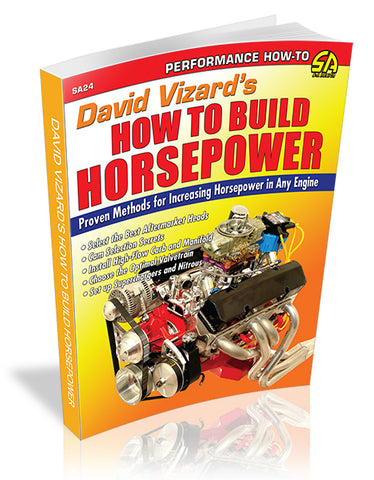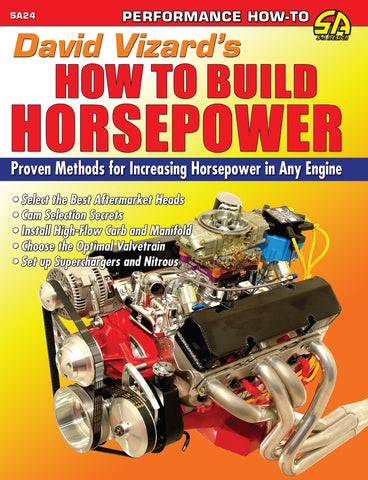Extracting maximum torque and horsepower from engines is an art as well as a science. David Vizard is an engineer and more aptly an engine building artist who guides the reader through all the aspects of power production and high-performance engine building. His proven high-performance engine building methods and techniques are revealed in this all-new edition of How to Build Horsepower. Vizard goes into extreme depth and detail for drawing maximum performance from any automotive engine. The production of power is covered from the most logical point from the air entering the engine all the way to spent gasses leaving through the exhaust. Explained is how to optimize all the components in between, such as selecting heads for maximum flow or port heads for superior power output, ideal valvetrain components, realizing the ideal rocker arm ratios for a particular application, secrets for selecting the best cam, and giving unique insight into all facets of cam performance. In addition, he covers how to select and setup superchargers, nitrous oxide, ignition and other vital aspects of high-performance engine building.
Vizard's top-selling How to Build Horsepower explains the latest and most effective engine building techniques and strategies. The reader is treated to the secrets and methods for building virtually any automotive engine. Vizard's unique and entertaining style of writing clearly explains the key principles and provides extreme detail and uncommon insight, so at-home engine builder can realize their performance goals.
Introduction
Chapter 1: The Basics of Every Known Speed Secret
The Dynamometer
When Isn’t Bigger Better?
Chapter 2: Primary Point Induction
Air Temperature
Ram Air: the Basics
Practical Density Issues
Significant Pressures and Flow
Element Clogging
Chapter 3: Fuel Delivery Systems
Mixture Ratio
Exhaust Pollutants
Mixture Quality
Carb Function Basics
WOT Calibrations
The Boosters
Idle and Transition Circuits
Acceleration Enrichment
Carbs—How Big?
Carbs Versus Fuel Injection
Chapter 4: Intake Manifolds
Length and Volume
V-8 Intake Manifolds
Tunnel Ram Intakes
Chapter 5: Supercharging
Supercharger Types
Turbos and Centrifugal Turbine Superchargers
Boost Curve Shapes
Supercharger Selection
Superchargers and Built Motors
Getting the Cam Right
Turbo Cams
Fueling System
Chapter 6: Cylinder Heads
Optimizing Cylinder Head Airflow
Valve Shrouding
Practical De-shrouding
Ports
Port Evolution
Cross-Sectional Area
Applied Basic Porting
Wet-Flow Testing
Compression Ratio
Chapter 7: Porting and Flow Testing
Building a Really Trick Low-Cost Bench
Flowing the Exhaust
Porting
Results
Chapter 8: Ignition Systems
Number-One Ignition Goal
The First Step
Plug Cables
Coils
Ignition Timing and Curves
Modified Motor Timing Requirements
Modified Ignition Systems
Expected Results
Chapter 9: Real Camshaft Science
Mechanical Attributes Simplified
Our Hi-Perf Four-Cycle Engine
Airflow Dynamics
Choosing a Cam
Chapter 10: Cam Event Criteria
Overlap
Optimal LCA
Duration
Valve Lift: How Much?
Chapter 11: Valvetrain: The Physical Build
Reading Cam Spec Data
Valvesprings
Tappets
Timing Gears
Cam Timing
Rockers
Chapter 12: The Short-Block Engine
The Block
The Rotating Assembly
Connecting Rods
Pistons
Rings
Lubrication System
Chapter 13: Exhaust Manifolds
Pipe Diameter
Alternative Configurations
Using This Header Tech
Chapter 14: Mufflers to Tail Pipes
Simple Steps to Success
Cats and Mufflers
Muffler Flow: How Much is Needed?
Pressure Waves
Crossover and Balance Pipes
The Ultimate System?
Source Guide
Glossary
Appendices
Extracting maximum torque and horsepower from engines is an art as well as a science. David Vizard is an engineer and more aptly an engine building artist who guides the reader through all the aspects of power production and high-performance engine building. His proven high-performance engine building methods and techniques are revealed in this all-new edition of How to Build Horsepower. Vizard goes into extreme depth and detail for drawing maximum performance from any automotive engine. The production of power is covered from the most logical point from the air entering the engine all the way to spent gasses leaving through the exhaust. Explained is how to optimize all the components in between, such as selecting heads for maximum flow or port heads for superior power output, ideal valvetrain components, realizing the ideal rocker arm ratios for a particular application, secrets for selecting the best cam, and giving unique insight into all facets of cam performance. In addition, he covers how to select and setup superchargers, nitrous oxide, ignition and other vital aspects of high-performance engine building.
Vizard's top-selling How to Build Horsepower explains the latest and most effective engine building techniques and strategies. The reader is treated to the secrets and methods for building virtually any automotive engine. Vizard's unique and entertaining style of writing clearly explains the key principles and provides extreme detail and uncommon insight, so at-home engine builder can realize their performance goals.
Introduction
Chapter 1: The Basics of Every Known Speed Secret
The Dynamometer
When Isn’t Bigger Better?
Chapter 2: Primary Point Induction
Air Temperature
Ram Air: the Basics
Practical Density Issues
Significant Pressures and Flow
Element Clogging
Chapter 3: Fuel Delivery Systems
Mixture Ratio
Exhaust Pollutants
Mixture Quality
Carb Function Basics
WOT Calibrations
The Boosters
Idle and Transition Circuits
Acceleration Enrichment
Carbs—How Big?
Carbs Versus Fuel Injection
Chapter 4: Intake Manifolds
Length and Volume
V-8 Intake Manifolds
Tunnel Ram Intakes
Chapter 5: Supercharging
Supercharger Types
Turbos and Centrifugal Turbine Superchargers
Boost Curve Shapes
Supercharger Selection
Superchargers and Built Motors
Getting the Cam Right
Turbo Cams
Fueling System
Chapter 6: Cylinder Heads
Optimizing Cylinder Head Airflow
Valve Shrouding
Practical De-shrouding
Ports
Port Evolution
Cross-Sectional Area
Applied Basic Porting
Wet-Flow Testing
Compression Ratio
Chapter 7: Porting and Flow Testing
Building a Really Trick Low-Cost Bench
Flowing the Exhaust
Porting
Results
Chapter 8: Ignition Systems
Number-One Ignition Goal
The First Step
Plug Cables
Coils
Ignition Timing and Curves
Modified Motor Timing Requirements
Modified Ignition Systems
Expected Results
Chapter 9: Real Camshaft Science
Mechanical Attributes Simplified
Our Hi-Perf Four-Cycle Engine
Airflow Dynamics
Choosing a Cam
Chapter 10: Cam Event Criteria
Overlap
Optimal LCA
Duration
Valve Lift: How Much?
Chapter 11: Valvetrain: The Physical Build
Reading Cam Spec Data
Valvesprings
Tappets
Timing Gears
Cam Timing
Rockers
Chapter 12: The Short-Block Engine
The Block
The Rotating Assembly
Connecting Rods
Pistons
Rings
Lubrication System
Chapter 13: Exhaust Manifolds
Pipe Diameter
Alternative Configurations
Using This Header Tech
Chapter 14: Mufflers to Tail Pipes
Simple Steps to Success
Cats and Mufflers
Muffler Flow: How Much is Needed?
Pressure Waves
Crossover and Balance Pipes
The Ultimate System?
Source Guide
Glossary
Appendices










